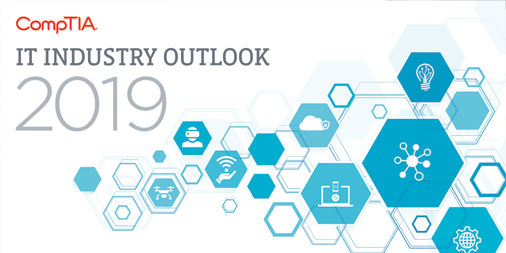
The technology industry has been through some turbulent times recently, quickly expanding from a historical focus on businesses to now touch nearly every facet of our lives. Not a day goes by without a headline centered on technology, whether it’s a positive development like a new product launch or something less happy like another major security breach. Against this backdrop, CompTIA’s 2019 IT Industry Outlook looks at a technology landscape that is rapidly changing but still needs skilled workers. Here are six takeaways from the report that will shape tech careers in the year ahead.
System Thinking Is Absolutely Critical
The underlying theme of the report is that there is no “next big thing,” no single technology that will change the face of IT. Instead, the trend is toward stackable technology, using different combinations to create a new result. Cloud computing will combine with edge computing and 5G networks to form a new infrastructure for economic activity. IoT and AI will be major drivers for ambient computing, where broad deployment of sensors will allow for environmental awareness and contextual automation. It won’t be enough to pick up a few new skills in a single area. IT pros will need to know how to use a variety of tools to build something innovative.
Support Needs Will Shift Along With User Behavior
Over the past several years, the balance of power has been shifting further and further away from a centralized IT organization. Distributed technology models—such as distributed databases, the Tor browser and now distributed ledgers—are disrupting established structures. Business units have more tech savvy than ever before, with roles that previously had no technical component becoming hybrid mixes of business process and technical acumen. Rather than removing the need for any central support, these changes simply redefine what that support looks like. Employees in a core IT function will need to understand which routine tasks are no longer critical and search for new, proactive ways to support users.
Skills Will Be Built In Many Different Ways
While there is a long-standing debate over the exact nature of the IT skills gap, there is no doubt that the dynamics of supply and demand are in flux. Some organizations that have never been aggressive technology adopters are now trying to push the envelope, while other firms are moving away from generalists and searching for specialists. In this environment, new paths for building and proving skills are emerging. Major tech companies like Apple, Google and IBM no longer require a four-year college degree for many positions, opening the door to those who have been through boot camps or have taught themselves. Some proof of competency (like CompTIA certifications) is still highly valuable, but job candidates are finding that they can get that proof through a variety of options.
It’s Not “Humans OR Machines,” It’s “Humans AND Machines”
The threat of robots taking over jobs has been making headlines for some time now. Without a doubt, there are many cases where automation will eliminate the need for specific tasks or even entire job categories. But there are two things to consider. First, this has always been the case (seen many lamplighters recently?). Second, the ability of machines to fully replicate the full range of human ability is still decades away. In that time, businesses will continue to blend computing automation with human innovation. Not only can humans find complementary ways to use technology for new results, but there will be a growing desire for a personal touch as the world becomes more digitized.
Technical Expertise Must Be Complemented With Professional Competencies
It’s not groundbreaking to say that IT pros need to place some emphasis on non-technical skills. Communication, customer service and teamwork have become more critical as IT takes on a more strategic role within the organization. These are not the only skills needed, though. Managing third parties will be important as companies demand more technology initiatives than the internal teams can support. More importantly, IT pros will have the opportunity to take the lead on discussions around ethics and unintended consequences. New uses of technology can lead to business growth, but they can also lead to privacy violations or social disruption. IT pros can take responsibility for technical innovation and help ensure it does not come at the cost of corporate reputation.
Technology Can Happen Anywhere
When the tech industry was smaller, there were certain places with a high concentration of technical talent. Silicon Valley was the main example, and major tech headquarters were also prime locations. Today, with every company accelerating their tech adoption and the barriers to innovation being lowered, IT pros can thrive in almost any location. CompTIA’s Tech Town Index highlights the places in the United States where technology demand intersects with affordability, and there are growing opportunities across the globe for doing interesting work and building communities around cutting-edge topics.
For more on the trends that will define the year in technology or details on the direction of the IT industry, check out the full report.

